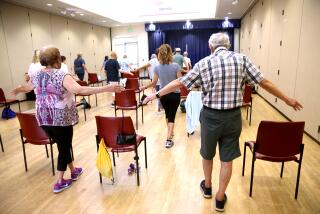The history of old age in America is all about reinvention. Too bad our political culture can’t keep up

- Share via
Book Review
Golden Years: How Americans Invented and Reinvented Old Age
By James Chappel
Basic Books: 368 pages, $32
If you buy books linked on our site, The Times may earn a commission from Bookshop.org, whose fees support independent bookstores.
In his groundbreaking 1980 account of the baby boomers, “Great Expectations,” Landon Y. Jones predicted that this generation would pioneer a new model for old age. The cohort born between 1946 and 1964 “promises to be relatively healthier, better educated, and more certain of its desires,” Jones wrote. “For the baby boomers, to be old may someday have all the possibilities of youth.”
Someday has arrived. And Jones turns out to have been prescient about this generation’s forever-young inclinations. But he may have been overly optimistic about the U.S. government’s ability or willingness to meet baby boomers’ burgeoning needs. James Chappel’s useful new social and cultural study, “Golden Years: How Americans Invented and Reinvented Old Age,” puts this shortfall in historical context.
Chappel, an associate professor of history at Duke University and a senior fellow at the Duke Aging Center, wears his erudition lightly. Writing in clear, accessible prose, he surveys a century’s worth of evolving understandings and experiences of old age in America. Through a progressive lens, he also examines some roads not taken — including the failure to create a more generous social safety net, pay more attention to disabled and minority populations, and reckon with the effects of climate change.

In his introduction, Chappel cites the long-term care crisis, the mounting cost of healthcare and a lack of labor protection for caregivers as major challenges. He notes that the old-age movement has “always been premised first and foremost on the needs of one class of people: middle-class, married, white couples.” It is true, he writes, that “older Americans report higher senses of subjective well-being than younger ones.” Nevertheless, older women living alone are “especially prone to poverty and isolation,” and people of color “have had limited access to Social Security, private pensions, and the various other mechanisms that the white middle classes used to fund their dignified retirements.”
Chappel’s chronological narrative is divided into three principal sections, each tied to a different conception of old age. In Part I, “The Aged (1900-1940),” he explores early pension movements and the creation of Social Security in 1935. For all its shortcomings, some mitigated over time, Chappel regards Social Security as “modestly progressive” and “our greatest-poverty reduction program.”
In “Didion & Babitz,” Lili Anolik reconsiders two Los Angeles icons.
Later in the book, he quotes criticisms of the program, which is not only regressively funded but, arguably, “an inefficient mélange of social insurance and welfare.” Social Security, Chappel notes, enshrines economic inequality by basing payments on past wages, which are correlated to race and gender. It gives money even to those who don’t need it, and is relatively stingy to those who do. Still, its very survival seems tied to its status as a universal benefit, which ensures a broad base of political support.
Part II, “Senior Citizens (1940-1975),” covers the passage of Medicare legislation in 1965 — like Social Security, a “moderate and compromised piece of legislation” that emerged after more radical alternatives failed. Chappel also discusses what he calls “the invention of retirement,” which spawned retirement communities, senior centers and nursing homes.
In a chapter devoted to Black gerontology and activism, he celebrates Jacquelyne Jackson, a sociologist at Duke University who fought unsuccessfully for Black people to gain earlier eligibility for Social Security benefits.
In Part III, “Older People (1975-2000),” Chappel tackles the rise of AARP, with its emphasis on combating ageism; the role of the 1985-’92 television series “The Golden Girls” in highlighting health and sexuality; the turn from pensions to riskier defined-contribution programs; and the development of “assisted living,” at home and in institutions.
Tom Pyun’s fast-paced ‘Something Close to Nothing’ uses everything from Meryl Streep to hip-hop dance to remind us that gay parents are as impulsive and conflicted as anyone else.
One of the strengths of “Golden Years” is its wide scope. But that broad brush means that Chappel doesn’t always dive deep. In the case of Social Security, for example, he never addresses the burden the program places on the self-employed, who, regardless of income level, pay double the taxes of employees. He mentions that Medicare has become more complicated. But he understates the labyrinthine complexities posed by competing and confusing Medigap and Medicare Advantage plans, each with different costs, practitioners and benefits designed to fill the lacunae left by original Medicare.
With the media paying increasing attention to the long-term care crisis, the perennial funding woes of Social Security and Medicare, and the paucity of retirement savings, much of the ground Chappel traverses is not novel. What is revelatory is his account of Black activism on these issues and various efforts over the decades to push the system toward greater fairness.
‘The Tonight Show’ uber host has been off the air longer than he was on it. Does Johnny Carson’s legend live?
Old-age pensions would have looked quite different, for example, had the federal government embraced the cause of the Ex-Slave Mutual Relief, Bounty and Pension Assn., which sought payments for the formerly enslaved. Or the Townsend Plan, which called for a sales tax to fund large pensions for everyone, irrespective of past earnings.
In his conclusion, Chappel weighs the United States’ indisputable successes against its failures in providing security to its aging population. Longer lifespans, however desirable, have also meant more physical and mental decrepitude, including dementia — a major theme in today’s popular culture and an almost intolerable burden on families, most often women.
Chappel laments the government’s seeming lack of will to address the problem. While Democratic presidential nominee Kamala Harris proposed a federally funded long-term care benefit, the idea likely died with her candidacy — at least for now.
To Chappel, the problem is even more fundamental. “American political culture,” he insists, “has lost its ability to have meaningful conversations about old age.” Time perhaps for the baby boomers, buttressed by their numbers and their considerable self-interest, to force the subject into the light.
Julia M. Klein is a cultural reporter and critic in Philadelphia.
More to Read
A cure for the common opinion
Get thought-provoking perspectives with our weekly newsletter.
You may occasionally receive promotional content from the Los Angeles Times.













